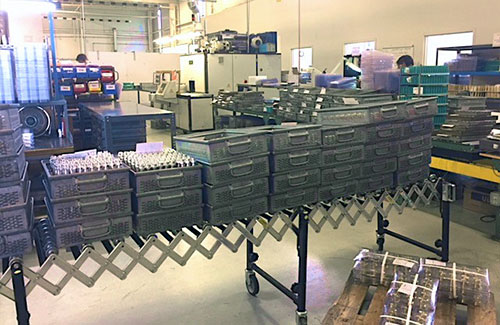
Production to Shipping Performance
DPA Helps Precision Metal Parts Company Speed Production-to-shipping Performance
A supplier of precision metal parts to automotive, electrical engineering, mechanical, medical, and industrial customers asked DPA to help it improve flow in the shipping department so that available goods are processed more efficiently.
Challenges
Product flow from production to finished goods storage was chaotic. Finding parts was difficult; employees had to hunt for parts to expedite orders. There was no First In First Out (FIFO) prioritization of parts through the Wash, Final Inspection and Shipping departments.
The company sought to increase overall productivity in the shipping department by 30% and reduce the more than 53,000 late parts in the system.
Mapping the Current Situation
The company’s kaizen team worked with DPA to put a continuous flow and FIFO process in place. They determined the demand and part quantities. They created spaghetti charts to map existing materials flow from parts washing to inspection to packaging to warehouse and shipping areas. They calculated takt time and reviewed cycle time versus takt time.
Implementing a Flow and Pull Strategy
After determining Every Part Every Interval (EPEI) demand within production’s final parts wash area, the team had the data to help them create a FIFO lane layout that would prioritize and organize parts flow from manufacturing to wash to inspection to shipping. Instead of having to purchase new conveyor belts, the team decided that repurposing the existing shelves would save time and money while eliminating the possibility of reverting back to the old system. They instantly committed to FIFO by emptying the two existing shelves in front of wash and by cutting them in two, they were able to make four equal height tables that just so happened to be the exact same height as the parts washer. They lined them up in an “L” shape in order to provide enough space for the machinists to drop off their parts during each shift without running out of space. They then manually placed all the inventory by work order date onto the new FIFO lane to feed the washer.
Employees were then approved to work overtime to process delayed parts through the new FIFO lane. The team also freed up space in the shipping area using 5S principles.
New Process Design: Flowing Material from Wash to Inspection and Packaging Through a Well-Organized FIFO Lane
Results
Time wasted hunting for priority-based jobs and grouping trays together is now replaced with an orderly conveyor that is worked in FIFO order with parts that are grouped together.
Within the first three days of the Kaizen event, setup of the new FIFO lane helped the company eliminate time searching for parts for inspection, prioritize parts going through the wash process and reduce the number of late parts by 27%!
New FIFO Lane Layout
Daily decisions on where to put people is now easily made with effective visual management. The person performing the washing is now able to also run the shipping area because he no longer needs assistance knowing what to work on next and the parts washer status is visible from his new shipping work cell. Since the wash machine loads automatically, he is able to move back and forth to keep both lanes flowing.
After the new system was operating for 90 days, DPA and the company’s management reviewed the results of action items completed in the project’s Kaizen newspaper. Since then, the company has eliminated all late parts in the system. The 30% productivity improvement goal was exceeded. Best of all, employees are energized to continuously seek ways to improve the operation.






